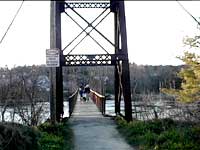Perils for Pedestrians
TV talk about people who walk
Pedestrian Bridges
What works, what doesn't.
Pedestrian bridges remove all conflicts with traffic on the road below. They would seem to be the perfect solution for getting pedestrians across the street. But are they always appropriate?
There are three main situations where a grade crossing is not possible and pedestrian bridges are essential:
Crossing interstate highways, where stopping traffic is not an option;
 Pedestrian
bridge over I-270 in Florissant, Missouri. Pedestrian bridges are needed
when road bridges are far apart.
Pedestrian
bridge over I-270 in Florissant, Missouri. Pedestrian bridges are needed
when road bridges are far apart.-
 Crossing rivers, ravines, and other natural physical obstacles;
Crossing rivers, ravines, and other natural physical obstacles; Pedestrian bridge across the Androscoggin River in Brunswick, Maine. This historic structure took workers from their homes north of the river to the mills south of the river.
-
 Crossing railroad switchyards, where parked trains block the path and
moving trains frequently shuttle back and forth on multiple tracks.
Crossing railroad switchyards, where parked trains block the path and
moving trains frequently shuttle back and forth on multiple tracks. Pedestrian bridge across a switchyard in Missoula, Montana. The bridge features both a winding ramp and an elevator at each end, and observing platforms for railfans at the midpoint.
There are situations where a grade crossing is possible, but a pedestrian bridge will be used voluntarily by most pedestrians and will be a good investment:
-
 The road is depressed in a cut, so the pedestrian bridge is at grade level
and seems more convenient than descending to road level;
The road is depressed in a cut, so the pedestrian bridge is at grade level
and seems more convenient than descending to road level; This street dips below grade in Lansing, Michigan, to allow a mid-block pedestrian plaza to cross over it at grade. The city also has crosswalks at adjacent intersections where the street is back at grade level.
-
There is a natural "desire line" that can be used for a gradual ramp up to the bridge without switchbacks or detours, such as where a rail-trail crosses a road.
 The Capital Crescent Trail in Bethesda, Maryland, ramps up to a bridge
over River Road. Trail users do not perceive the ramp as inconvenient
because it is along their natural line of travel, so most people elect
to use the bridge.
The Capital Crescent Trail in Bethesda, Maryland, ramps up to a bridge
over River Road. Trail users do not perceive the ramp as inconvenient
because it is along their natural line of travel, so most people elect
to use the bridge.
There are situations where bridges built to replace a grade crossing fail miserably.
-
Long winding ramps, stairs, or elevators, are perceived as inherently inconvenient by most pedestrians when a grade-level crossing is possible.
 This pedestrian bridge connects Prince George's Plaza with the nearby
Metrorail station in Hyattsville, Maryland. The design of the bridge and
its environment makes it seem inconvenient to many pedestrians. Half of
the pedestrians crossing here cross at grade level in the shadow of the
bridge.
This pedestrian bridge connects Prince George's Plaza with the nearby
Metrorail station in Hyattsville, Maryland. The design of the bridge and
its environment makes it seem inconvenient to many pedestrians. Half of
the pedestrians crossing here cross at grade level in the shadow of the
bridge.
-
In addition, because of their expense, bridges are usually far apart. Most pedestrians will not voluntarily accept the added inconvenience of walking ten or twenty minutes out of their way just to get to a bridge, and instead will cross at grade at the nearest convenient location.
Rather than create bridges that have both a convenient design and a convenient location, some transportation departments erect fences and barriers to force pedestrians to use the inferior bridges they do build. This Berlin-Wall approach to pedestrian control represents a failure to understand what pedestrians need.
Would a majority of pedestrians use a proposed bridge without being forced to by a fence?
If not, the designers need to work harder to improve the postive attractions of the bridge, rather than relying entirely on the negative barrier of the fence. A fence, if used at all, should be a supplement to good design, rather than the only incentive for pedestrians to use a poorly designed bridge in a poorly designed environment.
